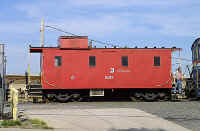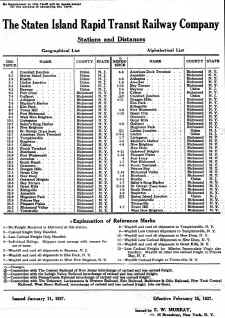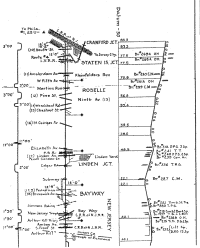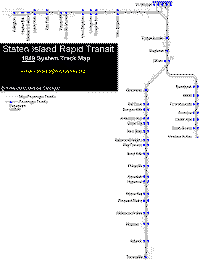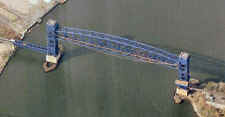December 17, 2004
Staten Island Rapid Transit History
The Baltimore and Ohio trackage in New Jersey consisted of a 5.5 mile segment, which ran from Cranford Jct. on the Central Railroad of New Jersey to Arthur Kill and on to Staten Island, NY. B&O trains reached this isolated property by trackage rights over the Reading Co. from Philadelphia, PA, to Bound Brook, NJ, then CNJ to Cranford Jct. The Lehigh Valley RR also maintained an interchange with SIRT at Cranford. Though strictly a freight operation in New Jersey, SIRT ran an urban style passenger rapid transit system on Staten Island which exists today under New York City's MTA.
With capital provided by the B&O the SIRT RR opened its first connection to the mainland rail network on June 13, 1889 over the first bridge over the Arthur Kill
waterway. The SIRT RR connected with the Pennsylvania Railroad in Linden, New Jersey, the Lehigh Valley Railroad at Staten Island Junction in Cranford, New Jersey and the Central Railroad of New Jersey at Cranford Junction, also in Cranford.
From the 1930s to the 1950s, primary interstate freight traffic terminated at the Baltimore & Ohio float bridges
in St. George, and many railroads, including the Chesapeake and Ohio had interstate trackage rights. Direct track connections were possible with the Lehigh Valley Railroad, Pennsylvania Railroad, Central Railroad of New Jersey and Reading Railroad, plus the carfloat operation which connected with offline terminals in Brooklyn, Queens, Bronx, Manhattan and New Jersey.
The Arthur Kill Vertical Lift Bridge replaced the original bridge in 1959 and carried freight until 1991 when traffic had essentially disappeared. From 2004 to 2006 the bridge was refurbished and freight service over the bridge, along the western portions of the North Shore Branch, resumed in
2007.
The freight line connection from New Jersey to the Staten Island Railway was restored in late 2006, and is operated in part by the Morristown and Erie Railway under contract with the State of New Jersey and other
companies. The Arthur Kill Vertical Lift Bridge which transports trains from Staten Island to New Jersey over the Arthur Kill waterway was renovated from 2004 to 2006 and began regular service on April 2, 2007, 16 years after the bridge
closed. A portion of the North Shore of the Staten Island Railway was rehabilitated, the Arlington Yard was expanded, and 6,500 feet (1,981 m) of new track was laid along the Travis Branch to Fresh Kills.[18] Soon after service restarted on the line Mayor of New York City Michael Bloomberg officially commemorated the reactivation on April 17, 2007.[19] On behalf of the City of New York, the New York City Economic Development Corporation formed an agreement with CSX Transportation, Norfolk Southern Railway, and Conrail to provide service over the reactivated line to haul waste from the Staten Island Transfer Station and ship container freight from the Howland Hook Marine Terminal and other industrial businesses.
0.0 St. George, NY (see below) 2.5 West Brighton 5.1 Arlington ----------- Travis Industrial Track Arlington Yard Con Edison Howland Hook Marine Terminal----------- 6.8 Arthur Kill Drawbridge 7.9 Bayway, NJ 9.2 Linden 10.9 Bantas 11.7 Staten Island Jct (with CR Lehigh Line) 12.2 Cranford Jct. (RVRR Interchange)
(circa 1960)
Cranford Junction, NJ to Arthur Kill, NY
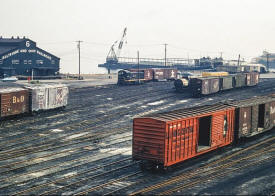
St. George B&O Railroad freight yard - View E
10/1971 Photo/Archive: William J. Brennan
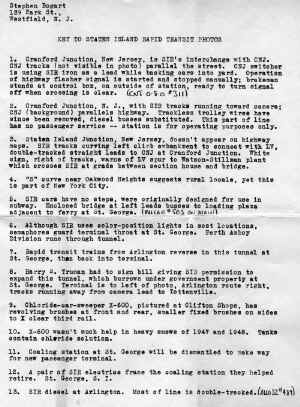
Stephen Bogart's photo research captions
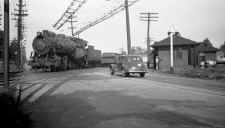
#1 SIRT CNJ 0-8-0 311 Switching Cars on SIRT Tracks at SIRT-CNJ Interchange Cranford Jct. - c. 1946
![]()
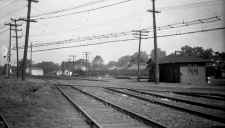
#2 SIRT Station - SIRT Tracks CNJ Camelback and Train - SIRT-CNJ Interchange at Cranford Jct. - c. 1946
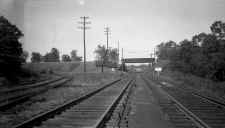
#3 SIRT Staten Island Jct , NJ - LV Tracks Over Bridge - c. 1946
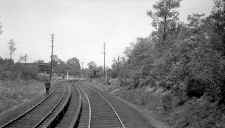
#4 SIRT-S Curve at Station Oakwood Heights - c. 1946
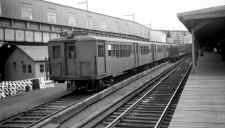
#5 SIRT MU 503 train Old Station St. George c. 1946
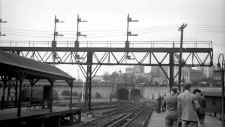
#6 SIRT Tunnel Yard Throat Tracks Semaphore Signals St. George c. 1946
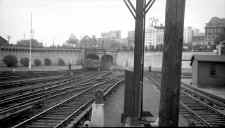
#7 SIRT MU one car train approaching Terminal - St. George - c. 1946
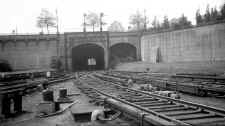
#8 SIRT-Tunnel -Yard Throat Tracks-Signals-St. George - c. 1946
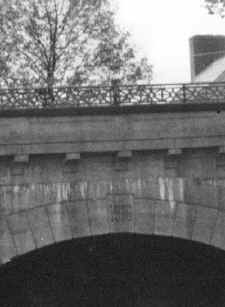
SIRT Closeup 1918 Bridge Constr. Date St. George c. 1946
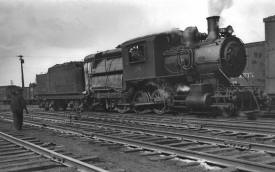
SIRT #28 St. George - 2/27/1937 Photo: Rod Dirkes
Archive: Mike Boland
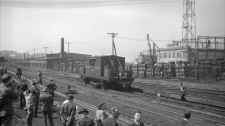
#9 SIRT Chloride Sweeper Car X-600 at Shops Clifton c. 1946
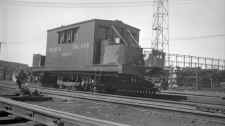
SIRT #10 Chloride Sweeper Car X-600 at Shops Clifton c. 1946
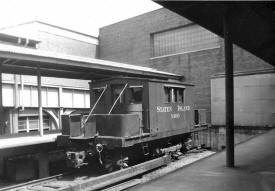
SIRT X-600 Sweeper St. George 5/15/1960 Photo: Harold Smith
Archive: Mike Boland
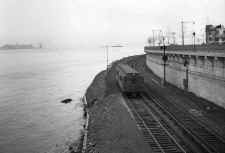
A one-car MU electric train is eastbound approaching the Staten Island Rapid Transit's shoreline station at New Brighton, Staten Island c. 1948. Richmond Terrace is elevated at the right. The tracks in the distance make the curve to the right and head towards the terminal at St. George. This branch, known in timetables as the North Shore Sub-division, ended passenger service on March 31, 1953 from St. George, eastward to Arlington and station buildings and platforms were removed. Freight service, however, continued for a number of years after but when it, too, came to an end, the tracks were torn up Today, Bank Street occupies the former right-of-way at New Brighton and provides access to the Richmond County Bank Ballpark. (Robert J. Wasche photo, Dave Keller archive and data)
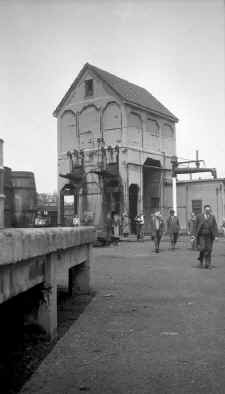
#11 SIRT Coaling Tower St. George c. 1946
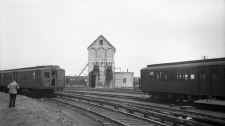
#12 SIRT MU Cars Coaling Tower
St. George c. 1946
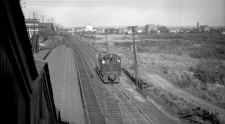
#13 SIRT ALCO S2 489 running light past Arlington Station c.1946
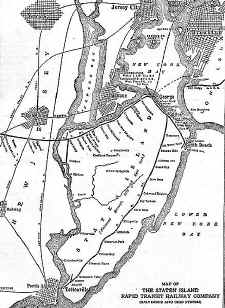
SIRT (B&O) 1952 freight connections map from timetable
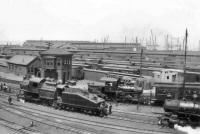
B&O #1183 1921 St. George Terminal Collection: Dave Keller
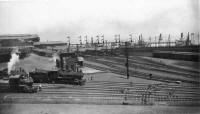
B&O #1347 1921 St. George Terminal Collection: Dave Keller
(circa 1949)
Staten Island, NY
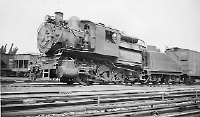
B&O 0-6-0 Camelback #1180
SIRT B&O St. George Yard 1933
Collection: Dave Keller
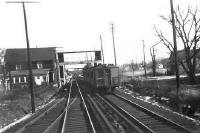
SIRT 2 Car train Richmond Valley
c.1950 Collection: Dave Keller
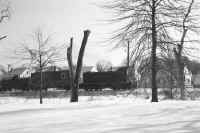
SIRT Alco S-2 #9029 Freight run c.1955 Collection: Dave Keller
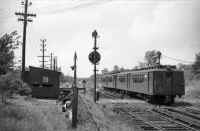
SIRT MU 2-car electric train eastbound for St. George is crossing Madera Street after making the station stop at Prince's (aka Princess) Bay in this view looking east in August, 1955 (Dave Keller archive, Ed Bommer data)
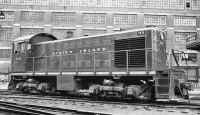
SIRT Alco S-2 #9033 at West 26th St., New York, NY 10-06-57
Collection: Dave Keller
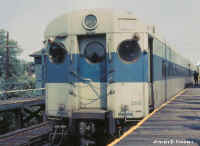
LIRR #2513 Photo: Joe Korman
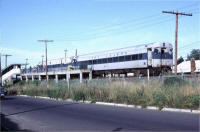
LIRR #2513 Jefferson Ave. 8/21/72
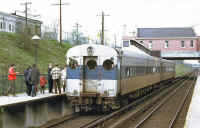
New Dorp Station LIRR #2509 04/28/1973 Fan Trip Photo: Joe Testagrose
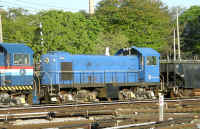
Ex-LIRR Alco S-1 #407 c.2000
Photo: Tom Healy
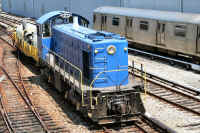
Ex-LIRR Alco S-1 #407 Clifton 05/25/2007 Photo: Bobby J. Kasza
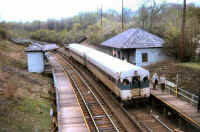
MU #2509 Two car train Princes Bay, Staten Island 04/28/1973
Archive: Dave Keller
Back in the early 1970s, the LIRR loaned or leased six (6) MU cars to the Staten Island Rapid Transit for their use.
These two LIRR MU cars are seen in SIRT service, stopped at Princes Bay station on Staten Island on April 28, 1973.
The LIRR never had any stations that looked like this structure and located in a cut. Also . . . . check out that shelter shed across from the depot building! Certainly not “Pennsy style!” Info: Dave Keller
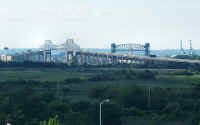
Arthur Kill Lift Bridge
08/12/07 view W from Hilton 6th floor Photo: Steve Lynch
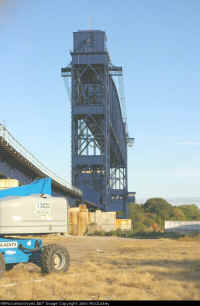
Arthur Kill Bayway, NJ view east 10/07/2006 Photo: John McCluskey
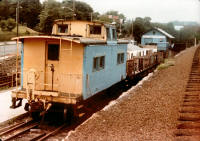
MOW Facility at Clifton Station 6/02/1975 Photo: Steve Lynch
Wiman oversaw the opening of the extension of the Main Line from its original Clifton terminus north to Tompkinsville on July 31, 1884; the opening of the North Shore Branch on February 23, 1886; and the South Beach Branch on March 8, 1886.
Wiman soon began negotiations with the leaders of the Baltimore and Ohio Railroad for the mutual benefit of the two companies that were then still independent. Being smaller than the Pennsylvania Railroad and the New York Central Railroad, the B&O relished the opportunity to start rail service to the potentially lucrative New York City market via collaboration with the SIRT RR.
With capital provided by the B&O the SIRT RR opened its first connection to the mainland rail network on June 13, 1889 over the first
bridge over the Arthur Kill waterway. The SIRT RR connected with the Pennsylvania Railroad in Linden,
NJ, the Lehigh Valley Railroad at Staten Island Junction in Cranford, NJ and the Central Railroad of New Jersey at Cranford Junction, also in Cranford.
From the 1930s to the 1950s, primary interstate freight traffic terminated at the
B&O car float bridges in St. George, and many railroads, including the Chesapeake and Ohio had interstate trackage rights. Direct track connections were possible with the Lehigh Valley Railroad, Pennsylvania Railroad, Central Railroad of New Jersey and Reading Railroad, plus the carfloat operation which connected with offline terminals in Brooklyn, Queens, Bronx, Manhattan and New Jersey.
Direct connections were also made to two small private railroads such as American Dock Company located at Tompkinsville and Pouch Terminal at Clifton. American Dock operated electric locomotives utilizing overhead trolley wire, while Pouch Terminal was first switched by a gas mechanical locomotive, then a Mack Diesel which has been preserved and now residing at Allaire State Park in New Jersey. American Dock and Pouch Terminal were both owned by different members of the Pouch family, but retained separate identities. The American Dock trackage despite being overhead trolley wire, did not connect with the Staten Island trolley system, but purchased power from them.
During the late 19th Century, a small 3 ft (914 mm) gauge railroad with a single 0-4-0 ran on Fort Wadsworth and connected with a team track on the South Beach line. .
The Arthur Kill Vertical Lift Bridge replaced the original bridge in 1959 and carried freight until 1991 when traffic had essentially disappeared. From 2004 to 2006 the bridge was refurbished and freight service over the bridge, along the western portions of the North Shore Branch, resumed in
2007.
The freight line connection from New Jersey to the Staten Island Railway was restored in late 2006, and is operated in part by the Morristown and Erie Railway under contract with the State of New Jersey and other companies. The Arthur Kill Vertical Lift Bridge which transports trains from Staten Island to New Jersey over the Arthur Kill waterway was renovated from 2004 to 2006 and began regular service on April 2, 2007, 16 years after the bridge closed.
A portion of the North Shore of the Staten Island Railway was rehabilitated, the Arlington Yard was expanded, and 6,500 feet (1,981 m) of new track was laid along the Travis Branch to Fresh
Kills. Soon after service restarted on the line Mayor of New York City Michael Bloomberg officially commemorated the reactivation on April 17,
2007. On behalf of the City of New York, the New York City Economic Development Corporation formed an agreement with CSX Transportation, Norfolk Southern Railway, and Conrail to provide service over the reactivated line to haul waste from the Staten Island Transfer Station and ship container freight from the Howland Hook Marine Terminal and other industrial businesses.
By 1973, the Jersey Central closed its car float yard at Jersey City. The B&O then moved its car float freight back to St. George on Staten Island. In September 1979, this car float operation was taken over by the New York Dock Railway and was terminated in 1980. The St. George Yard was essentially abandoned, except for servicing a few isolated Staten Island industries still using rail service.
The interline tariff routing arrangement used by B&O/Chessie to reach New Jersey and New York was ended by Conrail in the early 1980’s, leaving the line completely out of the New Jersey freight market. In April 1985, the operating rights for the tracks between Cranford Jct to St. George were sold to the Delaware-Otsego Corp. of Cooperstown, NY.
In April 1985, the Delaware Otsego / NYS&W took over the freight operations from the B&O/Chessie/SIRT. The railroad was named Staten Island Railway. They operated freight service between St. George Yard and Cranford Jct., NJ. Interchange was with Conrail on Tks 4 and 6 at Cranford Jct. At the time of the takeover, the NYS&W retained 4 former B&O train crew employees, 1 clerk, 1 AK Bridge operator and 1 trainmaster. Also included in the deal was former Chessie engine C&O 9051 which became NYS&W 120 and a caboose which became NYS&W 0121.The main customers on Staten Island at the time were Proctor & Gamble, US Lines at the Howland Hook Marine Terminal and Consolidated Edison. However, there were a handful of other customers some of which included Laminated Paper, Federal Plastics, Terminal Lumber and Cross Sinclair.
In 1986, the NYS&W took over the Rahway Valley Railroad. Customers I recall on the RVRR included Monsanto and Jaeger Lumber. The RV had 2 70-ton engines # 16 and # 17 which remained in RV paint the remainder of their lives under NYS&W control. Eventually as business on the Staten Island Railway declined, the SIRY crew also serviced the Rahway Valley customers crossing over the NJT Raritan Line at Excee Tower.
The SIRY crew and engine was based in Arlington Yard. My records indicate the last train to pull cars off Staten Island ran on March 9, 1991. The last train on SIRY-RVRR ran in April 1991 with engineer Anthony Carone (original B&O/Chessie employee) and Richard Travis as conductor. (I can't find the exact date but perhaps Rich Travis will read this and fill in the blanks) Over the years, eng 120 (painted in NYS&W yellow and black) was the primary engine used on Staten Island however the NYS&W 1800 series engines were also used at times.
Info: NaDspr
---------------
In the 60's and the 70's, carloads of rolled newspaper was delivered to the local paper on Staten Island, 'the Staten Island Advance". Later the print paper was brought in via truck.
FYI, when I worked at Phelps Dodge Corp, in the Traffic Dept. from 1968 to 1979, we moved freight over the B&O to St George.
This freight consisted of carloads of copper, railed to St George and floated to Laurel Hill on Newtown Creek in Queens for our refinery
They operated it. There was still business on the Island when they took over, however as the business left, the line became shorter and shorter. The main killer to the service there was the closing of the Proctor and Gamble plant which for the most part was the majority of the traffic on the island. Service ended towards the end of 92 with the locking of AK drawbridge in the upright position.
